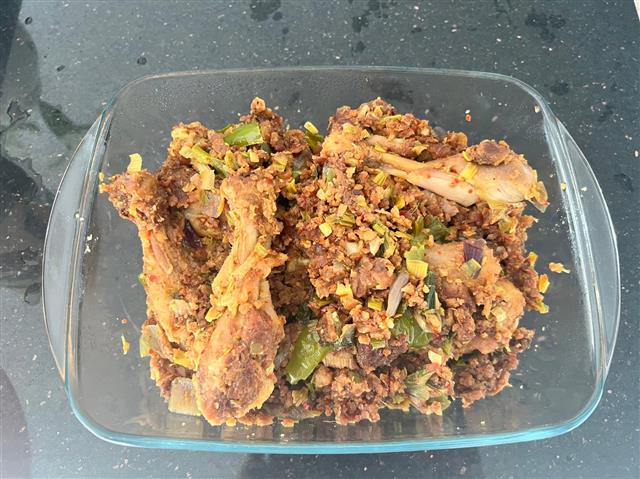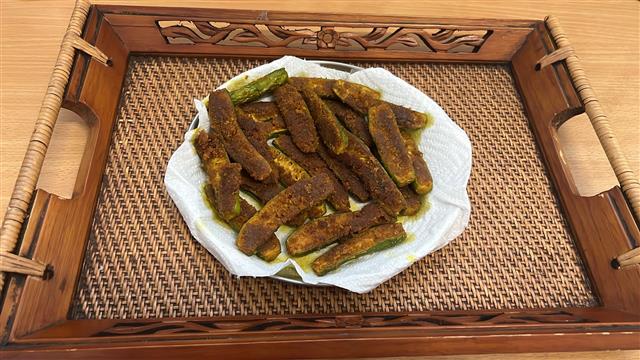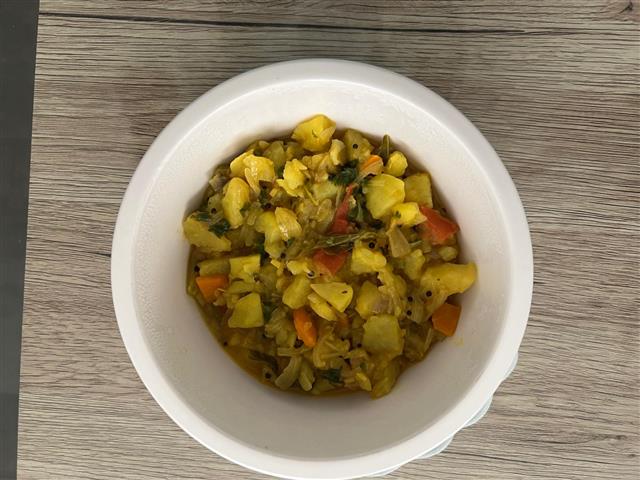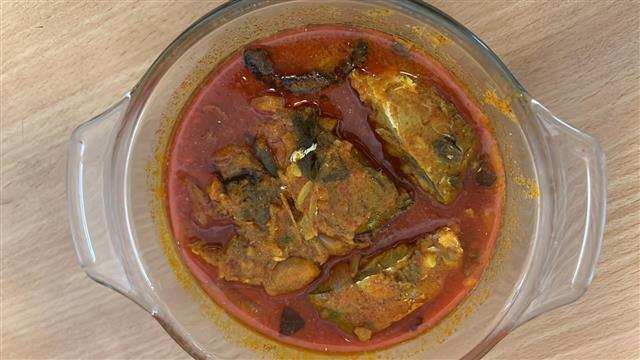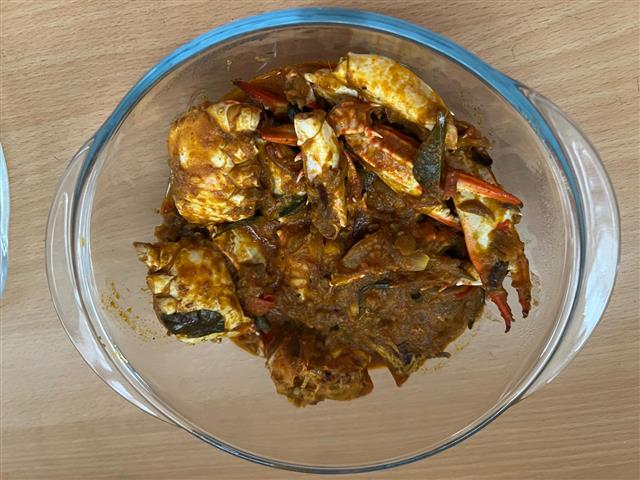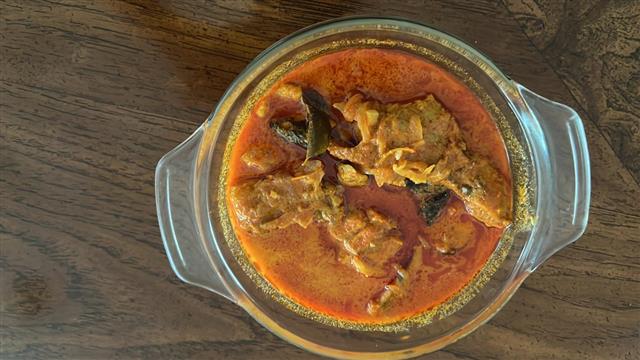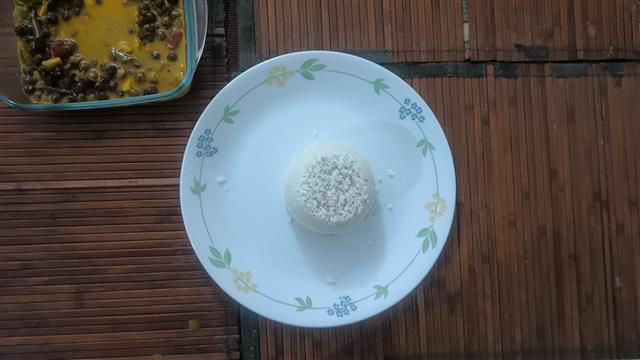
Appam
(4 reviews)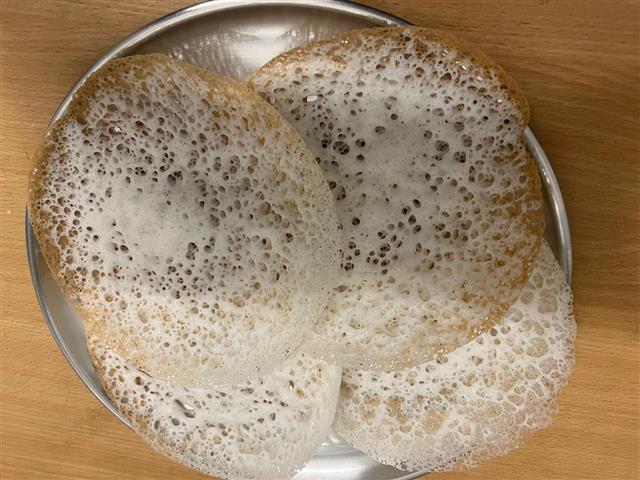
Appam is Kerala's signature rice pancake, soft in the center with lacy, crisp edges.
It's fermented, sweetish, and pairs beautifully with coconut-based stews and curries. The batter is made with raw rice, cooked rice, grated coconut, yeast, and sugar, and left to rise overnight.
Cooked in a curved Appachatti, each appam forms a delicate bowl that can hold stew, curry, or even coconut milk.
Ingredients
Directions
- Soak 1 glass of raw rice (Pachari) in water overnight.
- Grind the soaked rice with 1/2 glass of coconut and 1/4 glass of cooked rice.
- Add 2-2 1/2 teaspoons of sugar, 1/4 teaspoon of salt, and 1/4 teaspoon of yeast. Mix well and let it ferment overnight.
- When the batter is ready and has fermented, pour it into an Appam chatti (a special pan for making Appam) and cook the Appam.
Cooking Tips
• Use raw rice (pachari) for the best texture. Parboiled rice or brown rice gives a denser appam.
• The batter should be pourable. not too thick or watery.
• When pouring batter into the appachatti, immediately swirl to create an even flow.
• Appams are cooked only on one side. The steam sets the top, and flipping makes them rubbery.
• Before first use, lightly grease the pan with oil and heat it. This prevents sticking.
Marination Tips
• Test your yeast before mixing it into the batter. Dissolve it in lukewarm water with a pinch of sugar. If it bubbles in 5–10 minutes, it's active.
• If the batter doesn't rise, the yeast may be inactive.
• For colder climates, keep the batter near a warm spot.
How to Serve
• Kerala Mutton Stew – The classic festive combo
• Vegetable or Chicken Ishtu – Mild, coconut milk-based dishes work best
• Kadala Curry – A hearty and spicy black chickpea curry
• Sweet Coconut Milk – Just grated coconut with jaggery and a pinch of cardamom is a favourite combo for kids
• Fish Molee (Stew) – Delicate fish gravy infused with turmeric and coconut.
• Egg Curry – Both spicy and coconut versions pair well.
The Story Behind Appam
*stands out for its elegance, lightness, and laced beauty among Kerala's breakfast breads. For many Malayalis, Appam isn't just a breakfast dish. It's a comfort food tied to festivals, weekends, and cherished memories of family feasts.
The sound of batter hitting a hot chatti, the swirl of the pan, the hiss of steam when the lid is covered, this is the rhythm of weekend mornings and festival preparations in many homes.
Appam is said to have roots in Kerala's Syrian Christian community, where it was served with chicken or mutton stew for Easter, weddings, or special family brunches.
A beautiful symbol of Kerala's inclusive food heritage, the recipe has spread across the state and is embraced by all communities
In regions like Kottayam, some still make Appam in large batches using stone grinders and pour the batter into blackened and seasoned chattis.
In northern Kerala, the recipe sometimes includes a spoonful of coconut toddy (kallu) for natural fermentation.
In *urban homes, instant yeast now speeds up the process, but the heart of the dish remains the same.
What Is Appam?
Appam is a fermented rice pancake native to Kerala, typically eaten for breakfast or as a festive brunch. The dish has a soft, pillowy centre and thin, crisp laced edges, from the use of the curved pan (appachatti).
The batter is unique, made from raw rice, cooked rice, coconut, and a touch of sugar and yeast. Left to ferment overnight, the batter becomes airy and slightly sweet, producing a pancake that's tender yet crisp.
Appam differs from Vellayappam, which is thicker all over and has a steamed food texture. Don't confuse this with Idiyappam (string hoppers) or Neyyappam (fried sweet snack).
Appam is one of the most iconic dishes that has come out of Kerala.. It turns any meal into a celebration. Whether you pair it with stew, curry, or just sweetened coconut milk.
What do you do when you run out of yeast?
If you don't have yeast, don't worry. Though yeast is commonly used today for quick fermentation, Appam has always had alternatives.
In older homes, especially before packets of dry yeast lined supermarket shelves, toddy (kallu) was the natural fermenter.
Another beloved trick of mothers and grandmothers was to use a tablespoon of leftover fermented batter that they would have kept aside.
You can make appam the slow way by allowing the batter to naturally ferment for 24–36 hours, especially in warm weather.
Add a splash of coconut water, a pinch of baking soda or a tablespoon of sour curd before cooking, to nudge the batter to rise.
It may take a little longer, but the results are every bit as soft, airy, and flavourful.
Pro Tips for Perfect Results
→ Use a heavy-bottomed appachatti or a well-seasoned non-stick pan. Thin pans may burn the edges.
→ Don't rush the swirl.. Once the batter is poured in, swirl gently in one fluid motion. This creates even lacing.
→ Keep the lid covered while cooking to trap steam and help the centre fluff up without flipping.
→ Stir the batter gently before each use to redistribute any settled rice or coconut solids.
Appam Variations
Kallappam – Thicker, softer cousin of appam made in a dosa pan and sometimes with shallots or cumin.
Appam with Rava – Soaked semolina is blended with rice for a slightly different texture
No Yeast Appam – Use a touch of baking soda, curd, or naturally ferment the batter for over 24 hours
Coconut Milk Appam – Add a few tablespoons of thick coconut milk to the batter for a richer taste
Millet or Ragi Appam – A modern, healthy twist using foxtail millet or ragi flour for added fibre and colour
Sweet Appam – Mashed banana, extra sugar, and a pinch of cardamom for a dessert-like version. Serve with jaggery syrup.
Mini Appams (Paniyaram Style) – unniyappam or paniyaram pan used to make bite-sized appams, perfect for tiffin boxes or parties.
Diet-Friendly Adaptations
Vegan – Naturally vegan, as it contains no milk, butter, or eggs
Gluten-Free – Made entirely from rice, it's safe for gluten-sensitive diets
High-Fibre – Add a spoonful of oats to the soaked rice before grinding or substitute one-fourth cup of rice with other whole grains.
Storing & Reheating Tips
→ Storage: Store extra batter in the fridge for up to 3 days. Stir gently before each use.
→ Reheating: Sprinkle with water and steam for 2–3 minutes or reheat in a non-stick pan covered.
→ Freezing: Not recommended as both the batter and the thawed appam lose their airy texture.
Common Mistakes to Avoid
→ Under-fermented – Batter should rise and be airy. If not, the appams will be dense and flat.
→ Over-fermented – Too much fermentation gives a strong sour smell and affects the taste.
→ Wrong pan – Use an appachatti or curved non-stick pan for best lacing.
→ Thick batter – Won't swirl properly, leading to thick, clumsy appams. Add a few drops of water to the batter
→ Using hot water while grinding – Can kill the yeast and stop fermentation.
Frequently Asked Questions
- Can I use parboiled rice?
Yes, but the texture will be thicker and less lacy. Raw rice gives the classic soft-centre, crisp-edge balance.
- Why didn't my batter rise?
Either the yeast was old or the temperature wasn't warm enough. Make sure the water added to the yeast is lukewarm.
- Can I skip the yeast?
Yes. Let the batter ferment naturally for 24–36 hours, or use baking soda.
- Is appam served during festivals?
Definitely! It's a staple during festivals in many households.
- Can I add coconut milk to the batter?
Yes, for added richness. Add it just before cooking.
Equipment Needed
→ Appachatti (Appam pan) with lid – Traditional, curved non-stick pan for lacy edges
→ Mixer/Grinder – For a smooth batter
→ Fermentation Bowl – Preferably glass or steel
→ Ladle and Spatula– For greasing, pouring and serving
→ Spoon – To season the pan with oil
